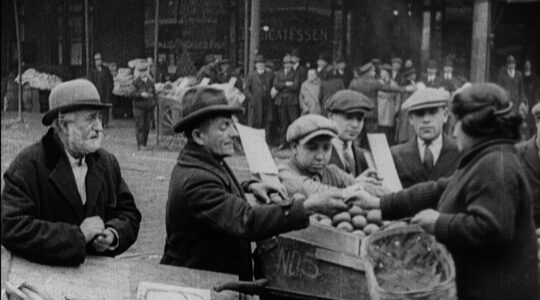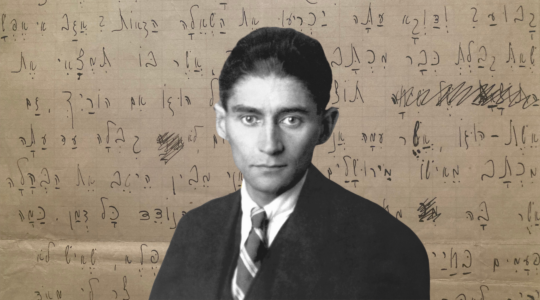In the death camp at Treblinka there was a fake railroad station that included a clock on which the painted hands always read 6 o’clock. The entire construction was a grotesque joke perpetrated by the camp’s commandant Fritz Stangl; in Treblinka, time stood still because all those brought there were dead from the moment they entered.
Claude Lanzmann mentions the clock in passing while interviewing Maurice Rossel in his hour-long film, “A Visitor from the Living.” Rossel was the naïve young Swiss Red Cross delegate who visited Terezin and reported back to his superiors that the ghetto there was a model, not realizing that he had been duped by his Nazi hosts. Lanzmann references the Treblinka timepiece in trying to convince Rossel, who still believes that the ghetto was a holding place for wealthy and influential Jews, of the depth of his foolishness.
At nearly 10 hours’ running time, “Shoah,” Lanzmann’s masterpiece, is a work of a certain appalling plenitude. It certainly feels like a definitive cinematic statement on the murder of six million Jews by the Nazis. Yet Lanzmann knew only too well how much was left to be said. In the three decades since the film was completed, he has made three short works that focus on specific aspects and witnesses like Rossel. Those films, “A Visitor from the Living” (1999), “Sobibor, Oct. 14, 1943, 4 p.m.” (2001), and his latest work, “The Karski Report” (2010) are getting a rare screening as part of the Film Comment Selects series at the Walter Reade Theatre.
Each of these three films, created from footage originally shot for the longer work, is as formally rigorous and as relentless as their big brother. “Visitor” consists of a long interview with Rossel, covering his attempt to gain access to Auschwitz and his infamous visit to Terezin; “Sobibor” is a 90-minute recounting of the uprising at the Sobibor death camp by a single survivor, Yehuda Lerner; “Karski” is a 49-minute excerpt from the second day of Lanzmann’s original interview with Polish resistance fighter Jan Karski, discussing his attempt to alert the outside world to the existence of the death camp at Belzec and the Nazis’ plans for annihilating European Jewry.
As in “Shoah” there is no archival footage, no voice-over narration, no music to cue emotional responses from an audience.
There is only Lanzmann, his interview subject and the camera and microphone. Occasionally in the two earlier films, as he did in “Shoah,” Lanzmann will show us the contemporary (1985) state of the scene of events described. Theresienstadt is an all-but empty town of old red brick. All that seems to be left of Sobibor are abandoned railway sidings.
But mainly we see the faces and hear the voices of three men who were there. We hear Rossel, still appalled and incredulous, remember that the Auschwitz commandant he met was “proud of the job they were doing. . . . They were doing something ‘useful.’”
We hear him acknowledge that his visit to Terezin “was clearly staged, . . . a theatrical presentation,” yet he insists that his report was essentially correct. We hear Yehuda Lerner, only 16 when he was dragged to Sobibor, tell Lanzmann that he “was already dead, so why not try to fight.” And we see Karski, whose testimony is one of the most vivid in “Shoah,” tell with a mixture of awe and disbelief of his encounters in Washington with Franklin Delano Roosevelt (“the most powerful man in all humanity”) and Justice Felix Frankfurter. Told of the Nazi plans and the existence of Belzec Frankfurter told him “I don’t believe you,” adding “I didn’t say [you’re] lying. … I cannot accept it.”
Karksi’s explanation for the unwillingness of Frankfurter to believe in the existence of the death camps in the middle of the war rings true. “The world is unprepared,” he told Lanzmann. “They had no precedent to compare [the Shoah] to.” Even forty years after the events, Karski says, he finds it hard to explain what happened when he is teaching. “I can’t handle it. History is cruel. Nations fight. People hate…” The unstated “but” hangs in the air.
“Shoah” and the three miniatures that followed it serve to rebut that “but,” just as Lanzmann intended. n
Film Comment Selects, presented by the Film Society of Lincoln Center, runs through March 4. The three films by Claude Lanzmann will screen individually, from Feb. 22-March 3, and Lanzmann will be present on Saturday, Feb. 26. In addition, the series features two other films of interest to Jewish Week readers, “Wundkanal” (1984), a docudrama about the kidnapping and interrogation of a Nazi war criminal directed by Thomas Harlan, son of the infamous Nazi filmmaker Veit Harlan, and “Our Nazi” (1985), a documentary about the making of that film by the radical American filmmaker Robert Kramer. It all takes place at the Walter Reade Theatre (165 W. 65th St.). For information, call (212) 875-5600 or go to www.filmlinc.com.
The New York Jewish Week brings you the stories behind the headlines, keeping you connected to Jewish life in New York. Help sustain the reporting you trust by donating today.




